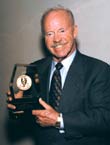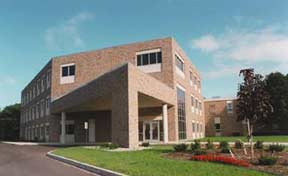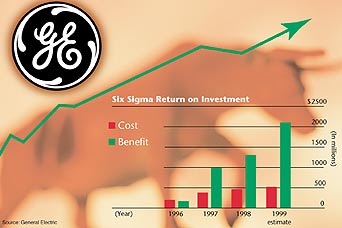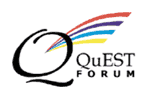As ISO 9000:2000 inches its way toward becoming an international standard, companies already registered to ISO 9000 and those planning registration are closely monitoring the
transition. A joint working group (JWG) between the International Organization for Standardization (ISO) and the International Accreditation Forum (IAF) met on Sept. 26, aiming at making that
transition as smooth as possible. The following agreements were reached at the meeting:  Registration to ISO 9001:2000 will not be granted until the publication of the new standard as an international standard. ISO 9000:2000 is
currently in the draft international standard (DIS) phase; ISO Technical Group 176 plans to publish the international standard in the fourth quarter of 2000.
Registration to ISO 9001:2000 will not be granted until the publication of the new standard as an international standard. ISO 9000:2000 is
currently in the draft international standard (DIS) phase; ISO Technical Group 176 plans to publish the international standard in the fourth quarter of 2000.
 Registration body assessments to the latest draft of the new standard
may begin prior to publication of the ISO 9001:2000 International Standard Assessing conformity to the latest draft (DIS or FDIS) may help organizations prepare for registration and take any necessary actions. To
minimize costs, currently registered organizations may want to be assessed to the latest draft of ISO 9001:2000 as part of surveillance or reassessment audits for their existing registrations. Registration body assessments to the latest draft of the new standard
may begin prior to publication of the ISO 9001:2000 International Standard Assessing conformity to the latest draft (DIS or FDIS) may help organizations prepare for registration and take any necessary actions. To
minimize costs, currently registered organizations may want to be assessed to the latest draft of ISO 9001:2000 as part of surveillance or reassessment audits for their existing registrations.
 Registrations to the 1994 editions of ISO 9001, 9002 or 9003 shall
have a maximum validity of three years from the publication date of ISO 9001:2000. Organizations with such registrations are encouraged to make the
transition to ISO 9001:2000 as soon as possible. However, because ISO 9001:2000 represents a fundamental change in approach from the 1994 series,
registration bodies may assess organizations against the 1994 standards for up to three years from the date of publication of ISO 9001:2000. Registrations to the 1994 editions of ISO 9001, 9002 or 9003 shall
have a maximum validity of three years from the publication date of ISO 9001:2000. Organizations with such registrations are encouraged to make the
transition to ISO 9001:2000 as soon as possible. However, because ISO 9001:2000 represents a fundamental change in approach from the 1994 series,
registration bodies may assess organizations against the 1994 standards for up to three years from the date of publication of ISO 9001:2000.
 ISO 9001:2000 will require auditors and other relevant certification/registration body personnel to demonstrate new competencies.
In the period following publication by ISO of ISO/DIS 9001:2000, accreditation surveillance will concentrate on how the registration
body is managing the change within its service. In particular, it will focus on the competence of the auditors and other relevant personnel with respect to the
aspects of the new standard that differ from those of the 1994 edition. ISO 9001:2000 will require auditors and other relevant certification/registration body personnel to demonstrate new competencies.
In the period following publication by ISO of ISO/DIS 9001:2000, accreditation surveillance will concentrate on how the registration
body is managing the change within its service. In particular, it will focus on the competence of the auditors and other relevant personnel with respect to the
aspects of the new standard that differ from those of the 1994 edition.
 Registration bodies will need to take particular care in defining the scope of certificates issued to ISO 9001:2000 and the permissible exclusions to the requirements of that standard. Replacement of the 1994
editions of ISO 9001, ISO 9002 and ISO 9003 with a single standard (ISO 9001:2000) will necessitate the use of a very clear and concise description of
the organization's activities that are included in the registration process.
Registration bodies will need to take particular care in defining the scope of certificates issued to ISO 9001:2000 and the permissible exclusions to the requirements of that standard. Replacement of the 1994
editions of ISO 9001, ISO 9002 and ISO 9003 with a single standard (ISO 9001:2000) will necessitate the use of a very clear and concise description of
the organization's activities that are included in the registration process.
"Industry expects that the introduction of the new ISO 9000 family of
standards will be a coordinated effort between the developers of the standards, certification bodies and accreditation bodies," a JWG member
announced while reporting on the first meeting of the JWG. The stated purpose of the JWG is to "establish common and consistent messages to ensure a smooth transition to the new standards."
For more information about the first JWG meeting and ISO 9000:2000, visit ISO's Web site at www.iso.ch or IAF's site at www.iaf.nu
. U.S. and European Standards Agreement
Fosters Free Trade
The National Institute for Standards and Technology (NIST) and the Commission of the European Communities signed an agreement on Oct. 5 that aims to eliminate redundant product testing that impedes the flow of products
between the world's largest trading partners. The agreement was designed to open the way for mutual acceptance of products and process-related measurements.
"The Implementing Arrangement for Cooperation in the Fields of Metrology and Measurements" is expected to lead to a system in which regulators on both
sides of the Atlantic can quickly determine, without additional testing, whether imported products meet the importing country's requirements.
Such a system was deemed necessary to realize the free trade goals outlined by the "U.S.-European Union Mutual Recognition Agreement" (MRA), which
became effective in December of 1998. The MRA covers six product areas that account for $50 billion in trans-Atlantic trade and calls for both parties to
accept as equivalent the results of tests, inspections and other evaluations performed by accredited laboratories or organi- zations on either continent.
Moreover, it furthers the aims of "The New Trans-Atlantic Agenda" launched by President Clinton and the European Council of Ministers in December of 1995.
The signing was preceded by an 18-month study involving NIST, its counterpart European national metrology institutes (NMIs) and more than 70
regulatory agencies in 18 nations. NIST established measurement equivalence with European NMIs, finding no differences of "practical importance." Instead,
it concluded that nontechnical issues were responsible for problems in securing acceptance of regulators in U.S. and European export markets. 
ISO 9000 Documents
Play a Role in a
Liability LawsuitW
hat did you know and when?" That question has become commonplace in made-for-television movies of governmental conspiracies and big-business
coverups. But what if your company's answer couldn't be carefully crafted by your public relations people? What if it were all documented--at considerable cost to you?
Your quality manual, created in preparation for ISO 9000 registration, could provide a paper trail that further exposes your company to legal liability. What
many feared would be the dark side of registration may now be surfacing. In a ruling that could establish a legal precedent, the Eastern District Court of
Arkansas recently ordered Case Corp. to furnish its ISO 9000 materials to the lawyers of several plaintiffs in liability lawsuits against the farm machine manufacturer.
Dozens of farmers are suing Case, claiming the company knew that design flaws existed in two of its cotton-picker models. The plaintiffs claim the
equipment is prone to accidental ignition, causing as many as 140 fires from 1994 to 1997, and therefore constitutes a nonconformance under Case's ISO 9000 registration.
If Case followed ISO 9000 procedures, all nonconformances should have been documented, the plaintiffs' attorneys argue. Therefore, it's imperative that they be allowed to review the ISO 9000 documentation. A brief filed on the farmers' behalf claims that ISO 9000 procedures required Case "to conduct a design validation, and take corrective and preventative
action" for nonconformances. "The design validation and the corrective and preventative action was documented," the brief states. "That documentation
was reviewed by management with executive responsibility. That documentation is relevant to this lawsuit and is discoverable."
Case's attorneys argued that the documents are privileged, but U.S. District Court Judge G. Thomas Eisele disagreed.
The plaintiffs hope to show that Case failed to conform to the requirements of its own quality manual. Legal liability is of growing concern to TC 176, the ISO technical committee
working on the 2000 edition of the standard. New clauses in ISO (DIS) 9000:2000 require registered organizations to have a procedure for identifying and accessing relevant laws and regulations.
Case's attorney, John Phelps of Womack, Landis, Phelps, McNeill & McDaniel in Jonesboro, Arkansas, declined to respond to our inquires. Metrology Companies Merge  Mahr Corp., a German metrology-instrument
manufacturer, completed a merger with U.S. Federal Products Co. on Oct. 28. The new conglomerate will be known as Mahr Federal Inc. Mahr Corp., a German metrology-instrument
manufacturer, completed a merger with U.S. Federal Products Co. on Oct. 28. The new conglomerate will be known as Mahr Federal Inc.
The Mahr Group, which was already one of the three largest producers of metrology equipment worldwide, purchased WEGU Meßtechnik GmbH, a German CMM manufacturer, in February. Since restructuring and globalization
in the mid-1990s, Mahr has experienced double-digit annual growth in sales and has founded several international facilities. Federal Products, one of the United States' largest metrology manufacturing
companies, is home to 430 employees and generates revenues of nearly $45 million. The company is well-known both as a producer of custom-designed measurement machines and as a calibration services provider.
The Mahr Group now consists of 16 businesses worldwide, with more than 1,500 employees. The group's 1999 sales are expected to reach $170 million.
Mahr's recent acquisitions indicate its active pursuit of an increased market share and its effective internationalization strategy. The new U.S. headquarters for Mahr Federal are in Providence, Rhode
Island, at a former Federal Products production facility. Contact Mahr Federal at (401) 784-3100, or visit www.mahr.com.  Crosby Medals for Quality Awarded Crosby Medals for Quality Awarded
At the Tenth Annual Conference of the American Society for Competitiveness (ASC), held on Oct. 20–23, five companies and one individual received the organization's Philip B. Crosby Medals for outstanding achievements in
quality. The medals were presented throughout the four-day Atlanta event by Philip Crosby, chairman and CEO of Philip Crosby Associates II and a pioneer of the quality movement.
Criteria for receipt of the medals includes formation of mission, vision, strategy, implementation of strategy and assessment of quality results. Research
teams at the Eberly College of Business at Indiana University of Pennsylvania identified companies that met these criteria, based on the quarterly financial
reports of the companies and other evidence of performance in 1998 and 1999. "These organizations have proven themselves competitive in markets all over
the globe with the primary weapon of quality," Crosby says. "In this global economy, the key to success is managing quality properly."
The Coca-Cola Co., the world's largest producer of soft drinks, received the Crosby Medal for global competitiveness. In addition to its namesake—its
flagship product— Coca-Cola sells more than 160 soft drink brands to 200 different countries. Enron Corp., a leading electricity and natural gas company, was awarded a
Crosby Medal for advancing global competitiveness through quality and alliance building. Other recognized companies include Georgia-Pacific for profitability turnaround, SCI Systems for global competitiveness through
quality manufacturing of electronic components and systems, and Southern Co. for outstanding profitability in a transition environment.
Former United Nations Ambassador Andrew Young was the sole individual awarded a Crosby Medal. At a Saturday session of the ASC conference, Philip Crosby presented the medal to Young for his accomplishments in
advancing global competitiveness through international policy. ASC's scope of activities include research, education, public forums and
journal publishing. Keynote speakers at the recent conference included business leaders from around the world. For more information about the American Society for Competitiveness,
contact ASC President Robert Lattimer at (404) 698-0837 or the organization's executive director, Abass Ali, at (724) 357-5928. Crosby writes a monthly online column for Quality Digest at www.qualitydigest.com .  ISO 9002 Registration Benefits Hospital and its Registrar ISO 9002 Registration Benefits Hospital and its Registrar
Memorial Medical Center of West Michigan began its
journey toward ISO 9002 registration in August of 1998. The fruits of its labor were realized on September 23, 1999, when SGS-ICS, an international ISO
9000 registrar, recommended it for registration after a three-day audit. The registration of Memorial Medical Center is the first of its kind in Michigan,
but as ISO 9000 standards are becoming more popular within the health care sector, dozens of other health care organizations have been registered worldwide.
However, Memorial Medical Center became only the second North American hospital to undergo what is called a "witnessed audit."
"As the name suggests, our certification process was 'witnessed' by the Registration Accreditation Board (RAB)," says Thomas Cressy, the
organizations director of medical records quality resource management. "SGS didn't have any experience certifying a health care organization to ISO 9002,
so RAB representatives monitored how they dealt with the process. It made it a lot more stressful--SGS was determined to cross all the t's and dot all the i's for RAB, which meant we had to do the same." GE Reports Record Earnings with Six Sigma
Following several years of steady growth, General Electric recently announced that its six sigma quality initiative had led the company to the highest quarterly profits in its history.  GE's earning rose 16 percent to $2.65 billion in the period, improvement that representatives
credited, in part, to the corporatewide six sigma initiative aimed at producing near-perfect quality and eliminating production defects. GE's earning rose 16 percent to $2.65 billion in the period, improvement that representatives
credited, in part, to the corporatewide six sigma initiative aimed at producing near-perfect quality and eliminating production defects.
"We didn't invent six sigma--we learned it," says a company letter to shareholders. GE embraced six sigma after monitoring Motorola's and
AlliedSignal's experiences with it. "The experiences of these two companies--which they shared with us--made the launch of our initiate much simpler and faster," the letter continues.
The six sigma project work at GE consists of five basic activities: defining, measuring, analyzing, improving and controlling processes. These projects
usually focus on improving customers' productivity and reducing their capital outlays while increasing the quality, speed and efficiency of GE's operations.
Its success with six sigma has prompted GE to infuse all aspects of the company with this quality philosophy. "The gates are open to the largest flood
of innovative ideas in world business," the letter states. These ideas are generated, improved upon and shared by 350 business segments--or, as we
think of them, 350 business laboratories. Today, these ideas center on spreading six sigma 'best practices' across our business operations."
GE credits six sigma with a 10-fold increase in the life of CT scanner X-ray tubes made by its Medical Systems sector. In addition, the company's
industrial diamond business has quadrupled its return on investment in six sigma. GE's railcar leasing business reduced turnaround time by 62 percent at
its repair shops, and the plastics business has saved $400 million and expects to save another $400 million by 2000. Operating margin, a critical measure of business efficiency and profitability,
had hovered around the 10-percent level for decades. In 1997, as six sigma embedded itself deeper into company operations, GE surpassed 15-percent
operating margin. Six sigma delivered more than $300 million to that year's operating income. Six sigma training is now an ironclad prerequisite for promotion to any
professional or managerial position in GE and a requirement for any award of stock options. Senior executive compensation is now heavily weighted toward
six sigma commitment and success, now increasingly defined as "eatable" financial returns, for the customers and the company alike.
GE is now home to nearly 4,000 full-time, fully trained black belts and master black belts: six sigma instructors, mentors and project leaders. More than
60,000 green belt part-time project leaders at GE have completed at least one six sigma project. 
ASQ Publishes
Telecommunications
Metrics
The American Society for Quality (ASQ) has published the first quality system metrics for the global telecommunications industry. TL 9000 Quality System Metrics, Book Two
consists of quality system metrics for hardware, software and services, which are an integral part of the TL 9000 registration process. Book Two is a complement to Quality System Requirements, Book One. The new publication was published by ASQ but developed by the Quality Excellence for Suppliers of Telecommunications (QuEST) Forum, a unique
partnership of telecommunications companies founded to foster continued quality and reliability in that field's products and services while reducing the costs of poor quality. Book Two
represents QuEST's set of quality system requirements, quality system cost and performance-based metrics building on international quality standards such as ISO 9000. "The requirements brought forth by the QuEST
Forum promote consistency, efficiency and improved customer satisfaction--something the telecommunication industry needs," says Krish Prabhu, president and CEO of Alcatel USA.
TL 9000 Quality System Metrics, Book Two is available for $45 from ASQ. To order, call (800) 248-1946 and request item #T1180. For more information, browse www.questforum.org
, or contact Jeff Weitzer, QuEST Forum program manager, at (414) 765-8672.  American Customer Satisfaction Index
Track customer satisfaction with U.S. companies online. The site offers archived American Customer Satisfaction Index (ACSI) ratings, an updated
ACSI newsletter and answers to frequently asked ACSI questions. Use the site to become a corporate sponsor, research current ACSI ratings or subscribe to the ACSI newsletter.
acsi.asq.org
Quality in Telecommunications Use the QuEST Forum Web page to order the TL 9000 Handbook and
keep up with the latest in quality excellence for telecommunications companies. Find out which companies are current members of the forum, contact QuEST, or search for upcoming meetings and events.
www.questforum.org Six Sigma Consulting
Tom Pyzdek is widely regarded as one of the world's leading experts on quality and six sigma, with several best-selling books and more than three
decades of professional experience. His site contains a definition of six sigma, results yielded by Pyzdek Consulting Inc. and the company's philosophical
approach to consulting. Surf the site to learn about Pyzdek Consulting's former clients and the success they've enjoyed.
www.pyzdek.com Malcolm Baldrige National Quality Award Visit the Library of Quality, view the winners list of the Malcolm Baldrige
National Quality Award, or learn about the history of the Baldrige Award and National Institute for Standards and Technology at this site. The "What's New"
link quickly takes you to the Baldrige National Quality Program news database. Research the award-application process, or use the Web site to apply for a position on the board of directors.
www.quality.nist.gov Quality Research
This National Science Foundation (NSF) program supports multidisciplinary research on quality-based partnerships between researchers and businesses or
other organizations. Transformations to Quality Organizations is a catalyst for ongoing multidisciplinary investigations aimed at helping organizations
understand and implement quality improvements more rapidly and successfully. The program is managed by the NSF and supported by the Leadership Steering Committee and the American Society for Quality along with business
and industry.
tqo.asq.org To submit your Web site for consideration, e-mail a description of its contents to contact_us . More quality-related links are available at www.qualitydigest.com/html/qlinks.html . |